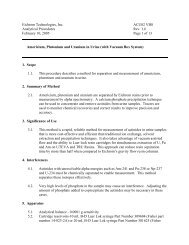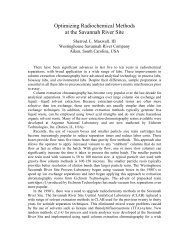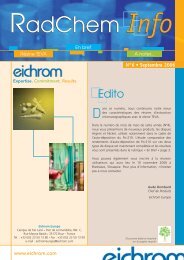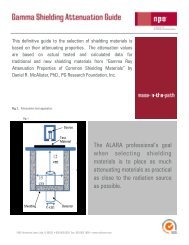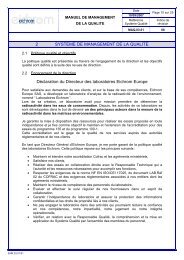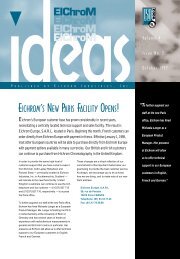Create successful ePaper yourself
Turn your PDF publications into a flip-book with our unique Google optimized e-Paper software.
Some test components are stored in freezers (-20 o C and -80 o C). Care should be taken to avoid<br />
direct contact of frozen components with skin.<br />
H. Pipetting Tips<br />
Table 2. Cross-Reactivity on the Procept ® Assay<br />
Procept® Assay<br />
Congener WHO 2005 TEF response factor<br />
2,3,7,8 TCDD 1 1<br />
1,2,3,7,8 PCDD 1 0.6<br />
2,3,4,7,8 PCDF 0.3 0.3<br />
1,2,3,7,8,9 HxCDD 0.1 0.5<br />
1,2,3,4,7,8 HxCDF 0.1 0.4<br />
1,2,3,4,7,8 HxCDD 0.1 0.4<br />
1,2,3,7,8,9 HxCDF 0.1 0.3<br />
1,2,3,6,7,8 HxCDF 0.1 0.2<br />
1,2,3,6,7,8 HxCDD 0.1 0.1<br />
2,3,4,6,7,8 HxCDF 0.1 0.1<br />
2,3,7,8 TCDF 0.1 0.06<br />
1,2,3,7,8 PCDF 0.03 0.1<br />
1,2,3,4,6,7,8 HpCDD 0.01 0.01<br />
1,2,3,4,6,7,8 HpCDF 0.01 0.05<br />
1,2,3,4,7,8,9 HpCDF 0.01 0.02<br />
1,2,3,4,6,7,8,9 OCDD 0.0003 0.000003<br />
1,2,3,4,6,7,8,9 OCDF 0.0003 0.0005<br />
The precision and accuracy of the Procept ® Rapid Dioxin assay can be affected by the pipetting<br />
technique of the user. Below are several pipetting tips for achieving the best possible results with the<br />
Procept ® Rapid Dioxin Assay.<br />
-Be consistent. Have a pipetting routine and keep the routine consistent throughout the samples in<br />
a single assay and between multiple runs of the assay.<br />
-When pipetting solvents with a higher vapor pressure than water (i.e. heptane or hexane), practice<br />
positive displacement pipetting. Draw the solvent into the pipet tip and dispense to the first stop on<br />
the dispensing mechanism (do not depress the dispensing mechanism to the second stop) to prime<br />
the pipettor. Repeat this procedure 2-3 times, then, draw the solvent into the pipette tip a final time<br />
and dispense the solvent into the desired container by depressing to the first stop of the dispensing<br />
mechanism. A small amount of solvent may remain in the pipette tip, but an accurately measured<br />
amount of the solvent will have been dispensed.<br />
-Use a fresh pipette tip for each sample/standard during the assay and for each dilution when<br />
preparing the 2,3,7,8-TCDD standards. This will minimize the possibility of cross-contamination<br />
between samples or standards.<br />
-Use the lid from the box of pipette tips and the pipette tips themselves to keep track of your<br />
position on the 96-well plate. When using a full test kit, it can be difficult to keep track of where each<br />
sample or standard should be added on the 96-well plate. The lid of the pipette tip box can be used<br />
to keep track of the column to which each sample or standard should be added. As the user<br />
progresses through the test and reaches the end of a column, the lid can be moved to the next<br />
column of the 96-well plate. Additionally, the pipette tips are organized in the same format as the<br />
96-well plate. By using a fresh pipette tip for each sample/standard and removing the pipet tips in<br />
www.eichrom.com 11/5/07 page 6 of 7




